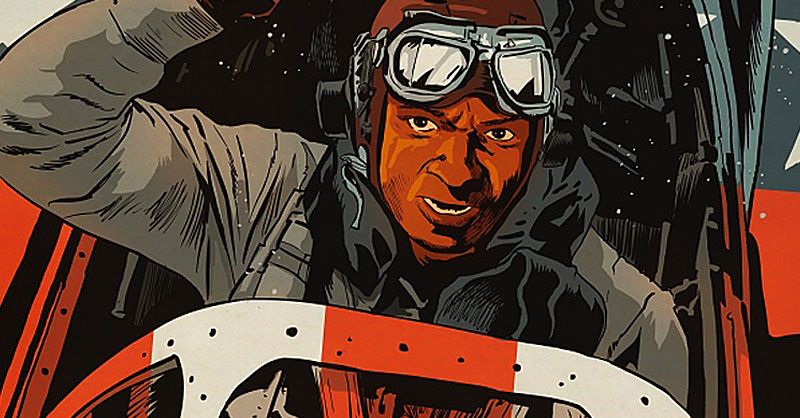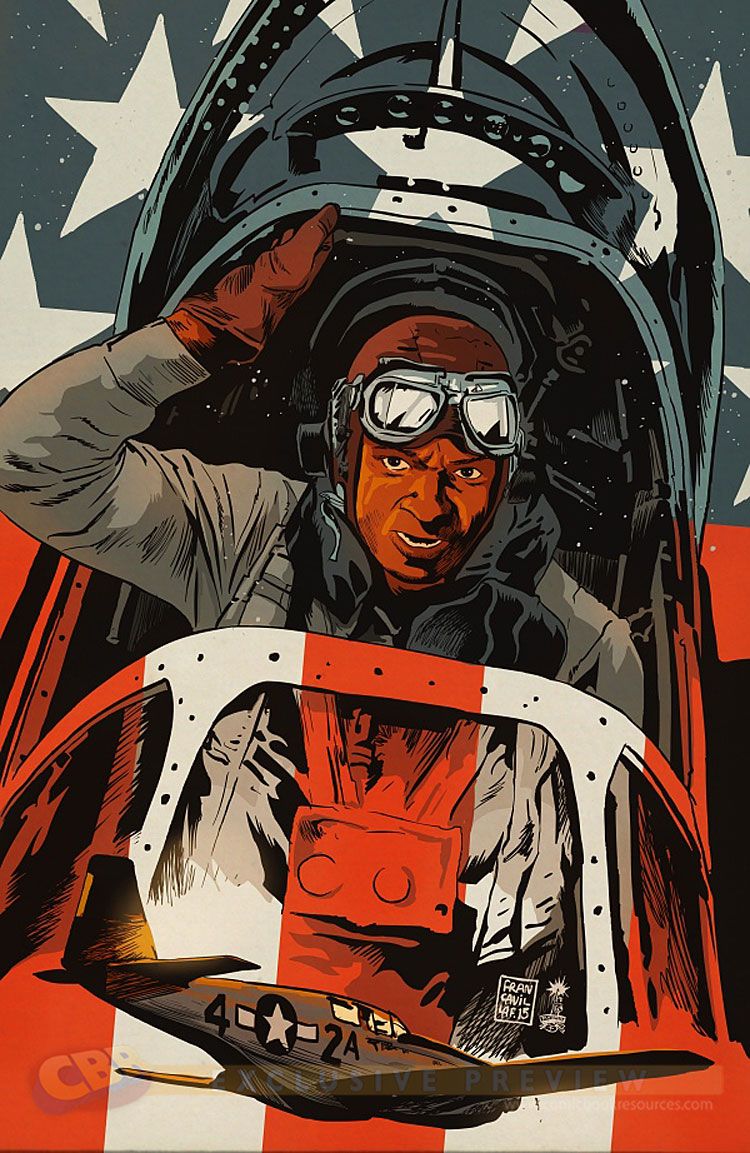With the release of its first title this December, AfterShock Comics is hoping to send shockwaves throughout the comic industry. After all, kicking off a publishing line with an all-new series by comics heavyweight Garth Ennis is a pretty sure way to guarantee attention. With "Dreaming Eagles," the writer behind such massive series as "Preacher" and "The Boys," and landmark runs on "Hellblazer" and "Punisher," joins with artist Simon Coleby ("2000 AD") to tell the story of the Tuskegee Airmen of World War II.
RELATED: Ennis, Conner, Palmiotti & More Helm AfterShock's First Slate of Releases
Inspired by true events, the series will tell the story of fictional WWII veteran Reggie Atkinson as he relays his experiences to his young son Lee, a budding activist involved in the Civil Rights Movement of the 1960s. "Dreaming Eagles" will follow the brave military pilots as they stand up against both the terrors of the Third Reich and the bigotry found in their own country.
In a CBR-exclusive first interview about the series, Ennis expresses his desire to cut through myth to find the heroic truth, reveals how a chance trip to a bar in New York City set this story in motion years ago, and why he will never be done writing about war.Plus, we have the first look at artist Francesco Francavilla's cover to "Dreaming Eagles" #1!
CBR News: Mark Waid and J.G. Jones recently received some criticism as a white creative team tackling a story of racial tensions in the American South of the '20s in "Strange Fruit." Do you have any concern that you'll face similar scrutiny in writing about the Tuskegee airmen and their experiences?
Garth Ennis: My attitude to that is that it's going to be what it's going to be; it's so far beyond my control that there's no point worrying about it. I'll write the best and most honest story I can, with appropriate attention to detail in terms of historical research. If you think I have no right to tell the story because I'm white, don't read it. If you don't think that and you're interested, give it a try.
How long has the Tuskegee story been on your mind, and have you ever considered working it into any of your previous war comics?
I've known about the Tuskegee Airmen for a long time, probably 20 or 25 years, maybe longer. But about fifteen years ago I chanced upon a bar on the upper east side called Archer's, and wondered why there were so many pictures of aircraft and pilots on the walls -- WW2 aircraft and pilots, on closer examination. The place was, of course, owned by Lee Archer, who was one of the 332nd Fighter Group's premier pilots -- he was actually their top scorer, if memory serves. Both the man and the bar are gone now, sadly, but that was the moment when I began thinking seriously about the Airmen and reading up on them.
I've only ever thought about telling the story as a self-contained piece, rather than as part of something larger. After all, the segregationist policies practiced by the military of the era saw to it that the Tuskegee story would be just that: self-contained. These guys had precious little opportunity to mix with other aircrew, so the thought of "guest-starring" one of them in another story just wouldn't work.
The solicit text talks about both high-flying action against Nazis and also more grounded drama pertaining to issues of discrimination in the era. What's the balance of that in the book? Is it mostly action adventure with real world undercurrents, or is it a big period piece drama with a little bit of derring do?
It's about half and half, largely due to the framing sequence (see below). The racial politics simply can't be ignored, but, equally it has to be remembered that the primary goal of these men was to fight the enemy -- and to do it as fighter pilots. So there'll be a good deal of high-flying action, yes.
I should also say that one of my concerns here is to do a bit of myth-busting. Due to the relative degree of fame they've enjoyed, there's been a fair degree of nonsense written about the Tuskegee Airmen. One of my particular bugbears is writers taking ordinary flesh and blood and rendering it into the impossibly superheroic, when what these men achieved in real life was incredible enough.
What can you tell us about the characters you'll be exploring this period of history through?
In the mid-'60s, at the height of the Civil Rights era, veteran Reggie Atkinson is telling his would-be activist son Lee about his experiences as a fighter pilot during the Second World War. This is partly at the behest of his wife, Alison, who's concerned at the gulf that's growing between the two men. We then move back to the '40s and see Reggie's experiences in training and combat, mostly along with his best friend Fats (and a couple of others who may or may not make it). There are a few other characters, actual real-life figures from the Tuskegee story, who'll figure in smaller roles.
When I'm writing war stories based on real-life events, I usually prefer to fictionalize the characters and base their actions and experiences on things that happened, rather than using the actual people concerned (the approach I took with the Night Witches, to name but one example). This is essentially because I believe it's disrespectful to those people and their relatives to use them as characters. It would be wrong of me, for instance, to take Lee Archer and have him express opinions that for all I know he never held, or act in ways he never did. I can't in all honesty say, "On this date and in this place, this man did and said this." That's why the lead characters in the story are invented, their experiences simply based on things that happened to people in real life.
That's said, you can't tell the story of the Tuskegee Airmen without featuring Benjamin O. Davis, who looms large -- and then some. He has to be in there. Likewise, I have no compunction about including a white USAAF colonel who wrote a particularly damaging (and largely invented) report on the 99th Fighter Squadron, which Davis had to answer for before Congress.
Hitler has been in fiction stories a million times, dating all the way back to when he was still in power. As this is a WWII story, s he a big part of this series? Do you have a different take on Hitler than we've seen before, or is Hitler simply Hitler?
Hitler doesn't really appear in the story, except as a background presence -- roughly speaking, a symbol of some of the things our heroes are fighting against. You have to remember, the 332nd were just one Fighter Group of many that escorted US bombers over Germany; if Hitler ever knew that the Americans had committed an all-black unit to combat, I've found no record of it. His mind was on what to him were weightier matters, such as the Soviet juggernaut approaching from the East.
So much of your bibliography is filled with war stories, and you've found homes for those tales across multiple publishers. Does you foresee a time when you won't have another war story to tell?
Short answer is, no. I read a lot of military history, and almost every book or article I check out suggests some new story, scene or character. I grew up on war stories the way just about everyone else in the business did on superheroes.
What's it like working for a new publisher? You've worked for so many that you must have an idea of what the strengths and weaknesses are, and what you look for when discussing a project with a new publisher.
It all comes down to people. Marie Javins at DC, for example, or Nick Lowe and Axel Alonso at Marvel. In this instance, I trusted Joe Pruett -- an old pal -- enough to at least take a look at what was on offer at AfterShock, and sure enough I was able to get what I wanted.
In a nutshell, you want the best deal and best working conditions possible, so that you can tell your story your way without interference. And -- here's one that gets overlooked a lot -- you want people who are simply good at their jobs to shepherd your story through the production process. Basic competence will take you a long way with me.
"Dreaming Eagles," by Garth Ennis and Simon Coleby, arrives December 30, 2105.
DREAMING EAGLES
Garth Ennis / Simon Coleby
All they asked for was the right to die for their country.
Logline: Inspired by true events. Dreaming Eagles tells the story of the first African American fighter pilots to join the United States Army Air Force in WWII and whose humble beginnings in Tuskegee, Alabama propelled them into the deadly skies above Adolf Hitler's Third Reich. Not only were they instrumental against the Nazi war machine, but also braved an equally great challenge, overcoming everyday bigotry amongst their fellow American soldiers as well as civilians at home. High in the heavens, they fought a battle that would change their country for all time.


